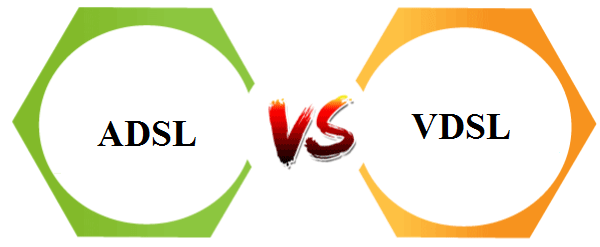Difference between ADSL and VDSLADSL and VDSL are both digital subscriber line (DSL) technology. These are mainly distinguished in the data transmission speed and data. VDSL is quite quicker than ADSL technology. ADSL offers an upstream data rate of 64 kbps to 1 Mbps; the downstream data rate ranges from 500 kbps to 8 Mbps. In contrast, VDSL offers an upstream data rate of 1.5 Mbps to 2.5 Mbps, and the downstream data rate ranges from 50 kbps to 55 Mbps. In this article, you will learn about the difference between ADSL and VDSL. But before discussing the differences, you must know about ADSL and VDSL with their features. What is ADSL?ADSL is an abbreviation for "Asymmetric Digital Subscriber Line". It is another form of DSL technology. It is a method that will offer faster Internet connection speeds than typical dial-up telephone lines. It is the system that underpins several Internet connections worldwide. Although modern fiber technology offers quicker Internet connections, ADSL remains a popular alternative due to its flexibility. Its bandwidth distribution is not similar, which means that it offers unequal data rates upstream and downstream. Typically, the data bit rates of downstream data are quite higher than the upstream data rates. ADSL divides the twisted pair cable bandwidth into three bands. The first band is POTS, which is utilized for conventional telephone operations ranging from 0 to 25 kHz. Furthermore, the service uses just 4 kHz of the band, with the remainder serving as a guard band that separates the voice channels from the data channels. The second band is utilized for upstream communication, which has a frequency range of 20 to 200 kHz. The third band is utilized for downstream transmission, which typically spans 200 to 1 MHz. ADSL technology has a range of up to 18000 feet. Features of ADSLThere are various features of ADSL technology. Some main features of ADSL technology are as follows:
What is VDSL?VDSL is an abbreviation for "Very High Bitrate Digital Subscriber Line technology". It transmits internet signals using an identical digital subscriber line. It is a newer technology than ADSL, providing a better user experience to Internet app users. The same subscriber line is utilized very effectively. Installing an optical node almost near the user's location provides connectivity to the users. This node is linked to the ISP via fiber optic cables. VDSL employs fiber optic, coaxial, and twisted pair cables to cover small lengths of up to 4500 feet. VDSL utilizes the DMT (Discrete Multitone Technique) modulation mechanism, a combination of FDM and QAM. On short lines, it has a higher capacity than ADSL. Another advantage of VDSL is the security provided by point-to-point connectivity. It employs seven distinct bands to allow for the customization of upstream and downstream rates. VDSL covers existing services, such as ADSL, POTS, ISDN, and various others. It is suitable for a full-service network and offers services such as HDTV (High-Definition television) and VOD (Video on demand). Features of VDSLThere are various features of VDSL technology. Some main features of VDSL technology are as follows:
Key differences between ADSL and VDSL
There are various key differences between ADSL and VDSL. Some of the key differences between ADSL and VDSL are as follows:
Head-to-head comparison between ADSL and VDSLHere, you will learn the head-to-head comparisons between ADSL and VDSL. The main differences between ADSL and VDSL are as follows:
ConclusionADSL and VDSL are primarily the forms of digital subscriber line technologies that should be recommended in the virtual world. VDSL provides better data speeds for twisted-pair copper telephone lines over short distances. In contrast, ADSL offers lower data rates but covers a greater distance than VDSL. VDSL has some disadvantages, such as being costly and that signal speed declines as distance rises.
Next TopicDifference Between
|
 For Videos Join Our Youtube Channel: Join Now
For Videos Join Our Youtube Channel: Join Now
Feedback
- Send your Feedback to [email protected]
Help Others, Please Share










